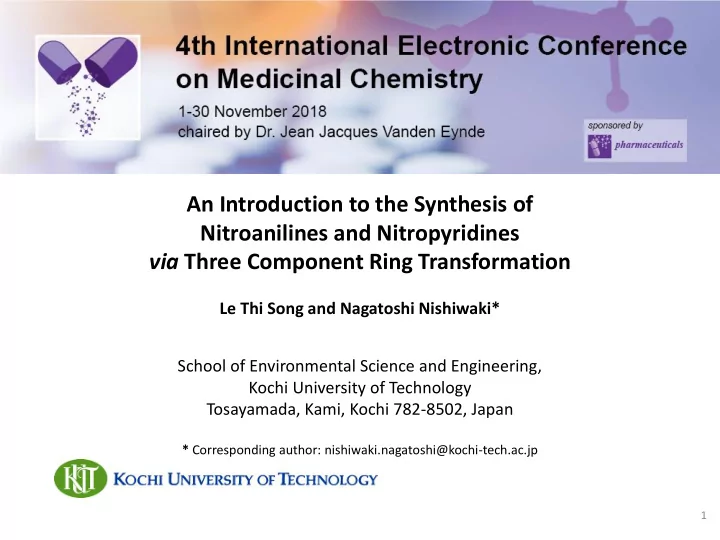

An Introduction to the Synthesis of Nitroanilines and Nitropyridines via Three Component Ring Transformation Le Thi Song and Nagatoshi Nishiwaki* School of Environmental Science and Engineering, Kochi University of Technology Tosayamada, Kami, Kochi 782-8502, Japan * Corresponding author: nishiwaki.nagatoshi@kochi-tech.ac.jp 1
An Introduction to the Synthesis of Nitroanilines and Nitropyridines via Three Component Ring Transformation 2
Abstract: A file syntheis of nitropyridines and nitroanilines are achieved by using a three component ring transformation of dinitropyridone 1 with ketones in the presence of less nucleophilic ammonium acetate (NH 4 OAc) as nitrogen source. When pyridone 1 was reacted with aromatic ketone in the presence of ammonium acetate, 6-arylated 3-nitropyriines 2 were formed besides diazabicyclo compounds 3 . This method was also applicable to cycloalkanones and α,β - unsaturated ketones to afford cycloalka[ b ]pyridines 4 and 6- alkynylated/alkenylated pyridines 5 , respectively. It was found to be possible to use aldehydes as the substrate, which leading to 3,5-disubstituted pyridines 6 . On the other hand, when aliphatic ketones were employed as the substrate, two kinds of ring transformation proceeded. Namely, 2,6-disubstituted 4-nitroanilines 8 were formed in addition to nitropyridines 7 . It was successful to apply this protocol to synthesis of N , N ,2,6-tetrasubstituted nitroanilines 9 upon treatment of dinitropyridone 1 with ketone and amine in the presence of acetic acid. Keywords: Ring Transformation; Dinitropyridone; Nitropyridine; Nitroaniline; Multi Component Reaction 3
Introduction Functionalized Heterocyclic Compounds are Useful for Medicines, Agricultural Chemicals, Dyes, Organic Electroluminescence etc. However, It is not Easy to Functionalize the Heterocyclic Framework. Hence, Efficient Functionalization Method should be Developed. Ring Transformation is One of the Solution for This Problem !! 4
What is the Ring Transformation? Scrap & Built Diels-Alder Type Degenerate Type 5
NewType Ring Transformation (Nucleophilic Type) Electron-Deficiency Substrate Should Have and Good Leaving Group 6
Preparation of 1 Reaction with 1,3-Dicarbonyl Compounds 7
Problem 1,3-Dicarbonyl Compounds are Useful Dinucleophilic Reagents, However, the Commercially Available Versatility is Low. If Simple Ketones can be Used, Synthetic Utility of This Method will be Considerably Improved. Solution Three Component Ring Transformation 8
Results and Discussion 9
Effect of Amount of NH 4 OAc 10
A Plausible Mechanism 11
Reaction with Other Aromatic Ketones 12
Reaction with Hetero Aromatic Ketones 13
Synthesis of TriSubstituted Pyridines 14
Pd Catalyzed C-C Bond Formation 15
Reaction with Unsaturated Ketones 16
Reaction with Aldehydes 17
Reaction Mechanism Using Aromatic Ketones 18
Reaction Mechanism Using Aliphatic Ketones 19
Synthesis of CycloAlka[ b ]Pyridines 20
Friedel-Crafts Alkylation Limitations PolyAlkylation may Occur • Rearrangement Proceeds to Afford Branched Alkyl Group • Arylation cannot be Achieved • Electron-Withdrawing Group Prevents • Amino Group also Prevents • 21
Synthesis of NitroAnilines 22
Synthesis of NitroAnilines 23
Synthesis of N -Modified NitroAnilines 24
Synthesis of N,N,2,6 -Modified NitroAnilines 25
Conclusions O 2 N R Metal-Free O 2 N N R Simple Manipulation N Easy Modification n O O H n NH 4 OAc R 1 NH 4 OAc R 1 O 2 N R 2 O R 3 R 4 NH O 2 N O 2 N NO 2 R 3 NH 4 OAc R 1 N AcOH R 2 R 4 R 2 N N O R 1 Me R 2 Ar O O 1 NH 4 OAc NH 4 OAc O 2 N NO 2 R 1 O 2 N R 1 O 2 N NO 2 + + O N N NH 2 Ar N N Ar Me H R 2 R 2 26
Acknowledgments Professors Prof. Kazuhiko Saigo (Kochi Univ. Tech.) Prof. Kazuya Kobiro (Kochi Univ. Tech.) Dr. Haruyasu Asahara (Kochi Univ. Tech.) Members of Nishiwaki Lab. 27
Special Scholarship Program (SSP) of Kochi Univ Tech 3-Year Doctoral Program Project-based English-medium instruction To support living expenses, 150,000 yen/month is paid for research project work. From Many Coutnries Bangladesh, Cambodia, China, Czech Republic, Egypt, Germany ,Ghana, India, Indonesia, Jordan, Latvia, Mongolia, Myanmar, Nepal, Niger, Pakistan, Poland, Spain, Sri Lanka, Thailand, Uzbekistan, Vietnam etc. If you are interested, please apply to this program. 28
Recommend
More recommend